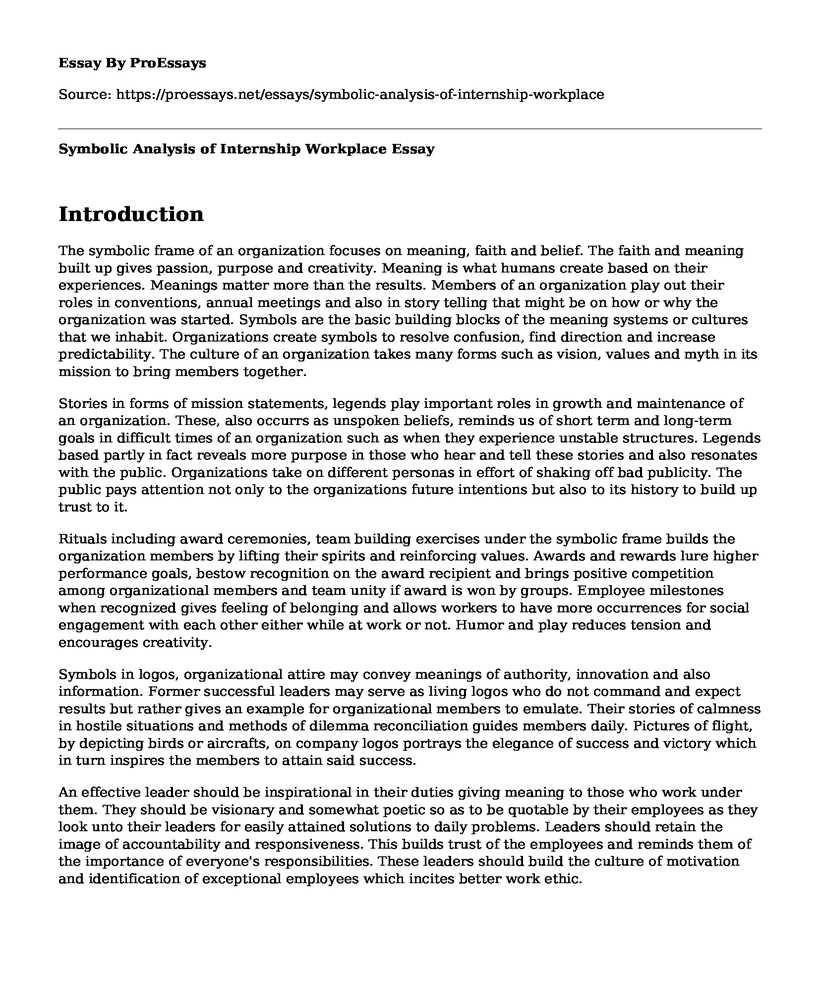Introduction
The symbolic frame of an organization focuses on meaning, faith and belief. The faith and meaning built up gives passion, purpose and creativity. Meaning is what humans create based on their experiences. Meanings matter more than the results. Members of an organization play out their roles in conventions, annual meetings and also in story telling that might be on how or why the organization was started. Symbols are the basic building blocks of the meaning systems or cultures that we inhabit. Organizations create symbols to resolve confusion, find direction and increase predictability. The culture of an organization takes many forms such as vision, values and myth in its mission to bring members together.
Stories in forms of mission statements, legends play important roles in growth and maintenance of an organization. These, also occurrs as unspoken beliefs, reminds us of short term and long-term goals in difficult times of an organization such as when they experience unstable structures. Legends based partly in fact reveals more purpose in those who hear and tell these stories and also resonates with the public. Organizations take on different personas in effort of shaking off bad publicity. The public pays attention not only to the organizations future intentions but also to its history to build up trust to it.
Rituals including award ceremonies, team building exercises under the symbolic frame builds the organization members by lifting their spirits and reinforcing values. Awards and rewards lure higher performance goals, bestow recognition on the award recipient and brings positive competition among organizational members and team unity if award is won by groups. Employee milestones when recognized gives feeling of belonging and allows workers to have more occurrences for social engagement with each other either while at work or not. Humor and play reduces tension and encourages creativity.
Symbols in logos, organizational attire may convey meanings of authority, innovation and also information. Former successful leaders may serve as living logos who do not command and expect results but rather gives an example for organizational members to emulate. Their stories of calmness in hostile situations and methods of dilemma reconciliation guides members daily. Pictures of flight, by depicting birds or aircrafts, on company logos portrays the elegance of success and victory which in turn inspires the members to attain said success.
An effective leader should be inspirational in their duties giving meaning to those who work under them. They should be visionary and somewhat poetic so as to be quotable by their employees as they look unto their leaders for easily attained solutions to daily problems. Leaders should retain the image of accountability and responsiveness. This builds trust of the employees and reminds them of the importance of everyone's responsibilities. These leaders should build the culture of motivation and identification of exceptional employees which incites better work ethic.
Conclusion
With most organizations paying more attention to the other three frames, that is: human resource, political and structural frames, they miss out completely on the advantages given by employing the symbolic frame. This might have been caused by this frame's nature of not being measurable or well explained but it is evident that it does actually work regardless of whether it is applied in a small or large organization.
Work Cited
Nunley, John M., et al. "College major, internship experience, and employment opportunities: Estimates from a resume audit." Labour Economics 38 (2016): 37-46.
Cite this page
Symbolic Analysis of Internship Workplace. (2022, Jun 23). Retrieved from https://proessays.net/essays/symbolic-analysis-of-internship-workplace
If you are the original author of this essay and no longer wish to have it published on the ProEssays website, please click below to request its removal:
- Personality Test Results and Future Job Performance. Essay Example
- Reference Letter for the Position of Specialized Technology Consultant
- Patient Care Assistant Paper Example
- Essay on NJ Motor Vehicles Commission: Breach of Employee Contract
- Essay on Outsourcing: Companies Should Provide Employment, But Is It Right?
- Chemical Safety in the Workplace: Protecting Workers and Businesses - Essay Sample
- Minimum Wage: A Price Floor for Workers' Rights - Essay Sample







